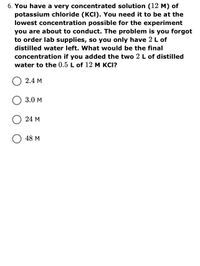
Chemistry
10th Edition
ISBN: 9781305957404
Author: Steven S. Zumdahl, Susan A. Zumdahl, Donald J. DeCoste
Publisher: Cengage Learning
expand_more
expand_more
format_list_bulleted
Question

Transcribed Image Text:6. You have a very concentrated solution (12 M) of
potassium chloride (KCI). You need it to be at the
lowest concentration possible for the experiment
you are about to conduct. The problem is you forgot
to order lab supplies, so you only have 2 L of
distilled water left. What would be the final
concentration if you added the two 2 L of distilled
water to the 0.5 L of 12 M KCI?
2.4 М
3.0 М
24 м
48 М
Expert Solution
This question has been solved!
Explore an expertly crafted, step-by-step solution for a thorough understanding of key concepts.
This is a popular solution
Trending nowThis is a popular solution!
Step by stepSolved in 3 steps

Knowledge Booster
Learn more about
Need a deep-dive on the concept behind this application? Look no further. Learn more about this topic, chemistry and related others by exploring similar questions and additional content below.Similar questions
- nitric acid could be used to neutralize barium hydroxide. if you have 0.432 L of a 0.555 M barium hydroxide solution, how much 3.00 M nitric acid will be required to neutralize it 0.240 L 0.160 L 0.0799 L or 0.719 Larrow_forward2- A sample of an acid 2.4 g dissolved in 100 ml. water. This sample was titrated with 40 ml sodium hydroxide (0.10 N). Find out the molecular mass of the acid knowing that it is mono-equivalent.arrow_forwardPart 3: What mass of tin was used to make the tin solution? In a similar experiment, a sample of tin metal was dissolved in nitric acid to produce 28.00 mL of solution containing Sn²+. Titration analysis resulted in the calculation that the concentration of Sn²+ in this solution was 0.65 mol/L. b. What mass of tin was used to make the tin solution? Find the mass of the Sn(s) in g: (give your answer to 2 decimal places) Your Answer: Answerarrow_forward
- In the laboratory you are asked to make a 0.128 m chromium(III) acetate solution using 475 grams of water. How many grams of chromium(III) acetate should you add? grams.arrow_forwardCalculate the mass (in mg) of BSA contained in a solution that is prepared by mixing 25. mL of a 1.0 mg/mL BSA solution, 25. mL of distilled water, and 2.4 mL of assay dye solution.arrow_forwardPlease answers this question. What is the molarity of a solution that contains 14.5 g of NaCl in 500. mL water? 2. How many moles of NaCl are present in 25.0 mL of 1.00 M NaCl? 3. If 15.00 mL of 2.00 M NaCl is diluted to 25.00 mL, what is the molarity of NaCl in the dilute. Thanks.arrow_forward
arrow_back_ios
arrow_forward_ios
Recommended textbooks for you
 ChemistryChemistryISBN:9781305957404Author:Steven S. Zumdahl, Susan A. Zumdahl, Donald J. DeCostePublisher:Cengage Learning
ChemistryChemistryISBN:9781305957404Author:Steven S. Zumdahl, Susan A. Zumdahl, Donald J. DeCostePublisher:Cengage Learning ChemistryChemistryISBN:9781259911156Author:Raymond Chang Dr., Jason Overby ProfessorPublisher:McGraw-Hill Education
ChemistryChemistryISBN:9781259911156Author:Raymond Chang Dr., Jason Overby ProfessorPublisher:McGraw-Hill Education Principles of Instrumental AnalysisChemistryISBN:9781305577213Author:Douglas A. Skoog, F. James Holler, Stanley R. CrouchPublisher:Cengage Learning
Principles of Instrumental AnalysisChemistryISBN:9781305577213Author:Douglas A. Skoog, F. James Holler, Stanley R. CrouchPublisher:Cengage Learning Organic ChemistryChemistryISBN:9780078021558Author:Janice Gorzynski Smith Dr.Publisher:McGraw-Hill Education
Organic ChemistryChemistryISBN:9780078021558Author:Janice Gorzynski Smith Dr.Publisher:McGraw-Hill Education Chemistry: Principles and ReactionsChemistryISBN:9781305079373Author:William L. Masterton, Cecile N. HurleyPublisher:Cengage Learning
Chemistry: Principles and ReactionsChemistryISBN:9781305079373Author:William L. Masterton, Cecile N. HurleyPublisher:Cengage Learning Elementary Principles of Chemical Processes, Bind...ChemistryISBN:9781118431221Author:Richard M. Felder, Ronald W. Rousseau, Lisa G. BullardPublisher:WILEY
Elementary Principles of Chemical Processes, Bind...ChemistryISBN:9781118431221Author:Richard M. Felder, Ronald W. Rousseau, Lisa G. BullardPublisher:WILEY

Chemistry
Chemistry
ISBN:9781305957404
Author:Steven S. Zumdahl, Susan A. Zumdahl, Donald J. DeCoste
Publisher:Cengage Learning

Chemistry
Chemistry
ISBN:9781259911156
Author:Raymond Chang Dr., Jason Overby Professor
Publisher:McGraw-Hill Education

Principles of Instrumental Analysis
Chemistry
ISBN:9781305577213
Author:Douglas A. Skoog, F. James Holler, Stanley R. Crouch
Publisher:Cengage Learning

Organic Chemistry
Chemistry
ISBN:9780078021558
Author:Janice Gorzynski Smith Dr.
Publisher:McGraw-Hill Education

Chemistry: Principles and Reactions
Chemistry
ISBN:9781305079373
Author:William L. Masterton, Cecile N. Hurley
Publisher:Cengage Learning

Elementary Principles of Chemical Processes, Bind...
Chemistry
ISBN:9781118431221
Author:Richard M. Felder, Ronald W. Rousseau, Lisa G. Bullard
Publisher:WILEY